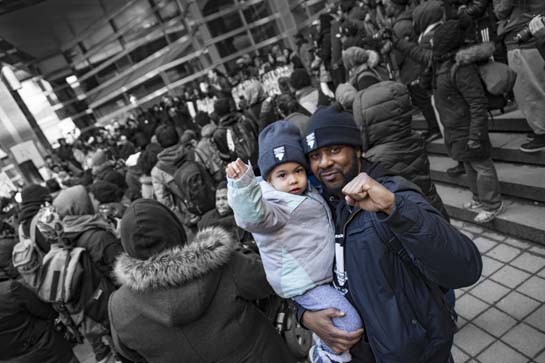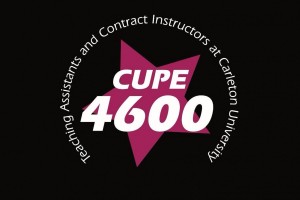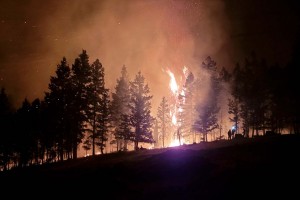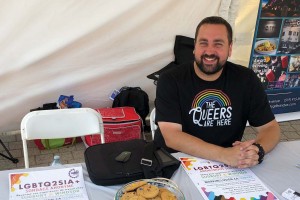"BLMTO, our ally team, Toronto's dedicated community organizers and new converts alike have been keeping #TentCity alive." These are the words of Janaya Khan, co-founder of the Black Lives Matter Toronto chapter.
Khan is referring to the March 2016 occupation outside Metro Toronto Police Headquarters, where demonstrators gathered to protest police violence and anti-Black racism. The ally team consisted of Indigenous, labour and community groups, all of whom played a pivotal role in helping to occupy the space.
Khan goes on to describe how Toronto police reacted to Tent City: "They attacked mostly Black women. They threw unknown chemicals into the air that landed on people's clothing and skin. They had agents in hazmat suits who poured those same chemicals onto the community fires, and broke and stole the tents."
Both Toronto Mayor John Tory and police Chief Mark Saunders remained silent, but their silence and the police over-reaction only fueled the resistance and solidified the occupiers' resolve: BLMTO acquired a sound system and a flatbed truck and organized a "BlackOUT Against Police Brutality" demonstration that saw hundreds if not thousands of people join them and shut down parts of College Street for a day. The dynamic crowd chanted, sang, danced and draped a banner stating "Black Lives Matter-Toronto" over the entrance to police headquarters.
The concerted efforts of all involved led Ontario Premier Kathleen Wynne to meet with organizers at the front of the Queen's Park legislature. There Wynne acknowledged the existence of anti-Black racism and committed to a review of the Special Investigations Unit (SIU).
Mandated to investigate police whenever injury, death or alleged sexual assault occurs as a result of their actions, the SIU has long been under fire from Toronto's Black community and others, with BLMTO now leading the fight. Final reports of the SIU's investigations as well as the names of officers involved in the cases are largely kept secret. And in more than 95 per cent of investigated cases, the SIU has laid no charges.
* * * * *
"The two most dynamic movements that reshaped the nation during the past three decades are the labour and civil rights movements." In 1965, in Springfield, Illinois, Dr. Martin Luther King spoke these words in a speech given to the AFL-CIO (American Federation of Labor and Congress of Industrial Organizations).
If we substitute the words Black Lives Matter for "civil rights," his words apply to one of the most dynamic movements reshaping North America today. Black Lives Matter is the modern-day civil rights movement.
Living wages, fair working conditions, pensions, livable and affordable housing, access to education: these continuing struggles of the labour movement transcend membership lists and directly affect the communities to which union members belong. The labour movement continues to fight for conditions that allow families — including chosen families — to grow, thrive and be respected.
Yolanda McClean occupied space at BLMTO's Tent City. She is the president of the Coalition of Black Trade Unionists-Ontario chapter and second Ontario vice-president of the Canadian Union of Public Employees (CUPE). She believes "BLMTO is about us. It's about solidarity against oppression, with our members, our families, and our communities. Black union members face anti-Black racism every day."
ANTI-BLACK RACISM ON BOTH SIDES OF THE BORDER
While the struggles of the civil rights movement have correlated with those of the labour movement almost since the labour movement began, in the 1930s when the North American trade union movement was in its infancy, the United States was under segregation.
It's often forgotten that in Canada we had every form of segregation as well, and that that segregation was just as virulently exercised within the labour movement itself.
Banned from most types of employment and from union membership, racialized workers resisted by, among other things, creating their own unions.
When African American and African Canadian porters were barred from the white-only labour union that represented sleeping car porters on both sides of the border, the civil rights leader A. Philip Randolph began an organizing campaign in the U.S. in 1925.
Twelve years later the Brotherhood of Sleeping Car Porters became the first African-American labour union to win a collective bargaining agreement and to gain a charter from the American Federation of Labour.
In 1946, the Brotherhood of Sleeping Car Porters organized the porters of both the Canadian Pacific (CP Rail) and the Northern Alberta Railway, and so became the first labour union in Canada organized by and for African Canadians.
Only after years of both internal and external struggle were non-white workers permitted to join other established unions. And few non-white workers dared to dream about becoming part of the leadership.
In his 1965 address to the AFL-CIO, Dr. King also said "The captains of industry did not lead this transformation; they resisted it until they were overcome." His words can easily be applied to labour unions themselves for their exclusion of Black workers. The unions resisted and were overcome.
Many argue that racism, anti-Blackness, sexism and other forms of bigotry remain within the labour movement today; however, the views of organized labour have evolved to a point where it is no longer uncommon to find both labour and the civil rights movement marching side by side on civil rights issues, on both sides of the Canada and United States border.
THE NEED TO WORK TOGETHER
Margaret X (not her last name), an organizer with Black Lives Matter in Austin, Texas, notes that the issue of low-paying work disproportionately affects workers of colour, and with BLM and the labour movement working together on the $15 minimum wage campaign, they have achieved notable successes in California, New York, Boston and Washington.
While the minimum-wage campaign has strong support, Margaret X feels the U.S. labour movement needs to be a far stronger ally around the issue of mass incarceration of Black and Indigenous populations.
In Canada, the same can be said.
Christopher Wilson protested with BLMTO at Tent City. A lawyer, and an international executive board member of the Coalition of Black Trade Unionists, he works as the Public Service Alliance of Canada's Ontario regional coordinator. However, he spoke to Our Times in his capacity as a community activist.
Wilson points to one of the main causes taken up by Black Lives Matter: "The extrajudicial killing of people of African descent and Indigenous people has been a long-standing struggle within our communities." He believes "the BLM movement has exposed the consequences of capitalist exploitation and state-sanctioned racism by taking action and raising awareness of that extrajudicial killing and the mass incarceration of people of our community."
To that end Wilson says, "There are many links between the Black liberation struggle and the class struggle. Canada's labour movement can play a key role in making those links."
He notes that "one of the slogans of the BLM movement is 'I can't breathe,' in response to the extrajudicial killing of Eric Garner." Garner was murdered in New York in 2014, when a police officer suffocated him in a chokehold. "That can be extended to the workplace by saying 'I can't work if I can't breathe.'
"What BLMTO has done is to reignite the Black liberation struggle through a renewed vision of action and militancy," he says.
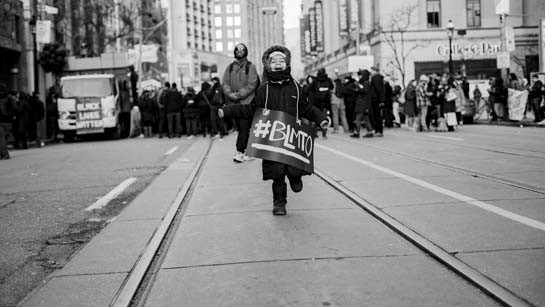
PHOTOGRAPH: C.J. CROMWELL
CONNECTING WITH OUR HISTORY
Ellie Ade Kur was also present at BLMTO's Tent City. A graduate student at the University of Toronto and an organizer with the Canadian Union of Public Employees (CUPE) Local 3902, Ade Kur notes that "the struggle with anti-Blackness within the affiliates" continues. She further believes that connecting Black Lives Matter to earlier manifestations of the movement is crucial. It's "important to recognize that the Black liberation movement has always been present.
As an example, Christopher Wilson further points to Toronto in the 1990s. "We need to remember the work of the Black Action Defence Committee, particularly around the Yonge Street Uprising in 1992."
In many ways the Black Action Defence Committee (BADC) was the Black Lives Matter movement of its time. Still engaged today in legal battles to hold the police accountable for their targeted surveillance of the Black community and their use of excessive force, the BADC was co-founded and led by the late Dudley Laws. In 1992, it was Toronto's civil rights movement.
In 1991, many in Toronto's Black community viewed and could relate to the videos being repeatedly aired of the police beating of cab driver Rodney King in Los Angeles, California. Tensions had been rising in Toronto and the surrounding area since the 1970s because of anti-Black racism and the continued police targeting and surveillance of Black people.
THE YONGE STREET UPRISING
The streets had also been marinated with the blood of several unarmed Black women and men shot by police. In December of 1988, Michael Wade Lawson, a 17-year-old Black male, drove through a police spot check in Mississauga, Ontario, in a stolen car. Peel Regional Police officers shot him several times in the back of the head with illegal, non-issued hollow point bullets as he was driving away.
Officer Anthony Melaragni was charged with second-degree murder and his colleague Darren Longpre was charged with aggravated assault. In 1992, an all-white jury acquitted them of all charges.
Lester Donaldson, a Black man carrying mental health issues, was also shot in 1988 when Toronto police confronted him in the rooming house where he lived. Officer David Deviney was later acquitted. This climate led Laws and others to found the Black Action Defence Committee.
In 1992, yet another Toronto police killing, this time of 22-year-old Raymond Lawrence, brought tensions to an all-time high.
The Yonge Street Uprising erupted in Toronto on May 4, 1992, after a demonstration organized by the Black Action Defence Committee attracted over a thousand participants. Considering these were the days before social media, this was no small achievement.
Once the demonstration was over, some participants vented their frustration through direct action and acts of civil disobedience. The headlines in the Toronto Star read "Hundreds riot downtown after anti-racism protest."
The circumstances led then-Premier Bob Rae to commission the Ontario NDP's Stephen Lewis to investigate the root causes of the social turmoil. His findings are documented in the Stephen Lewis Report, and though reforms were introduced at the time, they led to little overall change.
THE RISE OF BLACK LIVES MATTER
Let's adjust the date to February 26, 2012: A 17-year-old Black teenager named Trayvon Martin is murdered in Sanford, Florida. Neighbourhood watch coordinator George Zimmerman is later acquitted for the crime, and Martin is essentially placed on trial for his own murder.
The Black Lives Matter movement rises in response, with chapters soon forming in cities across the United States and Canada.
As young unarmed Black males and females continue to be killed at the hands of police, more chapters spring into action. Today, the Black Lives Matter movement is the largest anti-racism struggle in North America.
In Ontario, on September 24, 2014, a 33-year-old Black man named Jermaine Anthony Carby is shot and killed by a Peel Regional Police officer in Brampton, Ontario. The following summer, on July 5, 2015, Andrew Loku, a 45-year-old Black father of five with a history of mental illness, is shot and killed by Toronto police, only minutes after they arrive on the scene.
All of the officers involved are exonerated by the Special Investigations Unit (SIU).
The Black Lives Matter-Toronto chapter takes on the fight. The Coalition of Black Trade Unionists-Ontario chapter are with them from the beginning, and Canada's labour movement is not far behind.
UNAPOLOGETIC TACTICS
Black Lives Matter-Toronto has been described by virulent critics as the 1960s' Black Panther movement on steroids and by others as both a blessing to Toronto's Black community and a powerful changemaker.
Ellie Ade Kur feels BLMTO's Tent City had such a huge impact partly because "the tactics used by BLM are unapologetic."
Their organized approach of combining concrete demands with powerful direct action was evidenced again when they halted the 2016 Toronto Pride Parade for 24 minutes, until Pride organizers signed off on a list of demands. When the Pride executive later backtracked, BLMTO refused to waver, saying they would indeed be holding Pride to their word.
Wilson notes that BLMTO is also able to draw the media. He cites their success in generating "significant awareness through media around the case of Andrew Loku" as just one instance of how well they focus attention on the issues.
What also differentiates BLMTO from other organizations is its leadership structure.
On any given day any one of the BLMTO co-founders will present themselves as a proficient leader surrounded and supported by the Black, Indigenous and allied communities referred to as the family.
Wilson refers to the fact that BLMTO "created an extensive communication network called Ourfam that allowed for rapid mobilization around high-profile actions such as the rally at Queen's Park" during the Tent City occupation.
Says Wilson: "BLMTO is organized in a far less formal structure than trade unions. It has used that organic network along with social media to create a space that is inclusive with a broad reach within the community, particularly around young activists."
He feels one of BLMTO's great strengths is "the use of art, music and street theatre. That helped to create a liberatory space within Tent City. That space was open to Black and Indigenous activists."
Ellie Ade Kur agrees: "The space changed the environment for people and reclaimed it," she says.
REZONING GROUND ZERO
"Toronto Police Headquarters is ground zero. It's associated with violence, racism, carding." (Carding is the police practice of stopping people, disproportionately Black males, without giving them a reason, and then recording their information in a police database.) "Black and Indigenous people don't feel safe at police headquarters," continues Ade Kur. But the occupation "brought people who felt they couldn't be in that space together, and the space felt like it was ours."
What differentiates BLMTO even further is that many of their co-founders are young activists from the LGBTIQ+ community. They are the ones constructing plans that are holding the feet of both police and elected officials to the fire.
And Black Lives Matter has raised the bar for all activists by adding one three-letter-word to its name: the word "ALL."
"All Black Lives Matter" cries out for the inclusion of lives that would not ordinarily fit with most people's perceptions. "All" cries out that Trans Black lives matter, differently abled Black lives matter, LGBTIQ+ Black lives matter. Along with everyone else's lives, these Black lives matter.
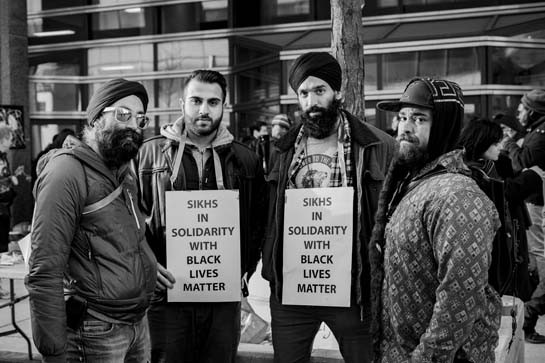
PHOTOGRAPH: C.J. CROMWELL
Yolanda McClean believes the labour movement can offer key supports to BLM.
"Labour is a support for grassroots folks, in actions like writing petitions, being on the streets and holding the government accountable for their actions." She feels "we have a role to share information and educate the public, especially our members, on why we need to support BLM."
Christopher Wilson feels labour's collective power is also crucial.
"One of the advantages of the Canadian labour movement," he says, is that it has the necessary "infrastructure and resources for sustained struggle." He points to the fact that an activist at Tent City created a hashtag called #asktorontolabourhope with the objective of calling upon labour to join the occupation.
COALITION OF BLACK TRADE UNIONISTS
The Coalition of Black Trade Unionists, says Wilson, knew their "role was to promote that hashtag within our own membership, contacts and within the movement and community. That was a role CBTU took on at the start of the occupation along with taking photos and images to tell the story."
He goes on to say that labour responded to BLMTO "with a number of endorsements through labour leaders, along with participation from rank and file members."
Indeed, labour was part of the ally team at Tent City, along with Indigenous and community groups. The ally team contributed much, including food, gift cards and other financial aid; and leaders from the Canadian Labour Congress (CLC), the Ontario Federation of Labour (OFL), the Toronto & York Region Labour Council, and various unions were all there.
Ellie Ade Kur points out, though, that labour needs to provide sustained support. She says, "Unions donated resources and time. However, when the rally ends and the cameras are off, we aren't holding labour accountable to the things that they were pledging to do around social justice and equity when the cameras were on."
She feels that if many of "the larger Canadian unions were to think more deliberately about issues of social justice, equity, diversity, and representation, it would lay the foundation for stronger forms of collective political action."
When CUPE Ontario held its 2016 provincial convention in May, Sandy Hudson, another co-founder of BLMTO and a CUPE member, addressed the delegates about the Black Lives Matter movement. In response, the various CUPE locals across Ontario raised $40,000 for the cause. The Toronto & York Region Labour Council's membership has also been raising funds at its membership meetings, as have other labour organizations in Ontario.
CHANGE NEEDS TO HAPPEN
Yolanda McClean stresses that the labour movement needs to do more. "There are 3 million unionists across Canada. We have the ability to reach workers for anti-racist political action. This can lead to difficult conversations but it needs to be done.
"Toronto is predominantly racialized and change needs to happen. We can no longer be a 'part of the meal.' It's time for racialized workers to 'plan the menu' and be at the table to make the decisions so we can be part of the change."
McClean revisits the interconnectedness of labour struggles and civil rights struggles and shows that labour ignores the latter at its own peril: "If we don't confront racialism now, if we don't continue to organize, mobilize and work with our community groups the labour movement will not exist — because labour and community are intertwined."
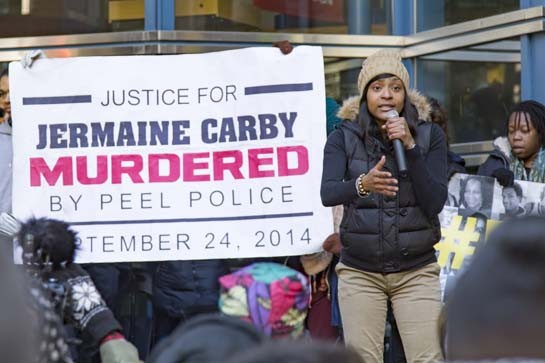
PHOTOGRAPH: C.J. CROMWELL
Many have argued, as McClean does, that the anti-racism struggle is inextricably bound to labour's external, and internal, struggles. So much of what labour fights for — securing living wages, closing the gender wage gap, ensuring affordable housing, and more — goes back to the material inequality on which both racism and misogyny thrive.
In many ways racism, misogyny, and their insatiable appetite for material inequality are the reason white women in Canada earn approximately 70 per cent of what a white man makes for doing the same job, and the reason women of colour make even less. No present-day institution or organization — including labour — can claim to be totally free of racism and misogyny, so deeply are they woven into the fabric of Canadian society.
Until organized labour successfully eradicates them from within the labour movement and works to do so throughout society, labour's ongoing fight to improve workers' conditions will result in only minor improvements.
As Ade Kur bluntly states, "If labour does not support Black Lives Matter they are not supporting their own workers."
The goals of Black Lives Matter mirror the best aspirations of the labour movement: The concept of every life mattering equally is embraced by the human rights and equity committees of almost every union in Canada. Wilson says BLM "maintains the position that we are not finished." And from BLMTO to Black Lives Matter Vancouver to Black Lives Matter throughout the U.S., these young activists are indeed changing society.
The collective strength of both organized labour and organized community working together towards a common goal threatens to reshape this nation bursting with inequity into a nation where every life matters. Equally.
Thanks to Christopher Wilson for the original idea for this story.
.......................................................
HOW TENT CITY CHANGED T.O.
Yusra K. Ali, a co-founder of the Black Lives Matter Toronto Chapter, speaks to Our Times about the impact of Tent City:
PHOTOGRAPH: C.J. CROMWELL
There have been a lot of gains that came out of Tent City. Some of our demands were that the police officers' names and the footage that captured the murder of Andrew Loku be made public information.
We also wanted to have an overhaul of the SIU because of its lack of transparency in accountability measures, so that it really can hold police accountable when they are negatively interacting with our community.
Other demands are connected to Jermaine Carby. We were able to have a motion passed within City Hall to investigate the ways in which anti-Black racism manifests itself in the SIU.
Premier Kathleen Wynne set provincial meetings across the four quadrants of the city including Regent Park, Jane and Finch, Eglinton West and Scarborough. These were to talk about how police violence affects our lives.
This is also bringing forward the ways in which Andrew Loku's death is representative of how so many Black lives die at the hands of police.
The province has now also called for oversight of the SIU, to investigate the ways in which this body is not accountable. That's one of the basic demands we pushed for that has actualized itself.
Since Tent City, a lot of people have been talking about Andrew Loku, about being Black and carrying mental illness. That's a majority of who is targeted when they are murdered by police. Typically, because they are the most marginalized and vulnerable in our community, they are under attack.
There has also been an inquest that has been called into Andrew Loku's death, and we are now getting information about what happened the day of his murder. Some of the information that is coming out hasn't done much to achieve the accountability that we want; what the SIU has released did not give us much information about what happened.
However, we are getting details as days pass and the more that we push — details that have come out of the case. For example, the footage that documented his murder.
We are seeing inconsistencies with the SIU's reporting and what had happened because the footage that actually caught his murder was deleted from the camera recording.
We found out that on the night Andrew Loku was murdered police illegally took the footage out of sight, which is a complete breach of the Police Services Act of Ontario.
So for us to have the inquest details on what happened to Andrew Loku — that's essentially opening up a conversation about the corruption that happens within policing and the ways in which there is a lack of transparency within these processes.
We can use this conversation to open up accountability measures and have justice when police are killing us. A lot has been done and the demands are being met with time. — YKA
Mark Brown is an executive board member of the Coalition of Black Trade Unionists and the assistant secretary-treasurer for the Canadian Union of Postal Workers (CUPW) Toronto Local.


